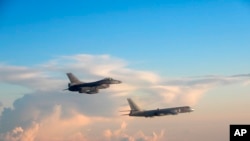A median line cited by Taiwan's military, when it wards off Chinese fighter jets, has never become a formal agreement, giving the Chinese side license to cross it without violating any agreement, analysts in Taipei say.
The line, which runs northeast from near Japan's outlying islands to the southwest near Hong Kong along the middle of the Taiwan Strait, "has just one definition", a Taiwan Ministry of National Defense source said Monday, referencing a mid-2019 report by the government-funded Central News Agency. A former defense minister detailed the line's exact latitudes and longitude coordinates during a legislative hearing in 2004, the report says.
A Chinese foreign ministry spokesman said in September the line doesn't exist. Experts in Taiwan say the line, established during the Cold War with U.S. help, never reached the status of a formal agreement.
"It's not to say that some previous deal is being violated against Taiwan, because actually no third party was ever in the middle, nor did any two parties sign a legally binding agreement," said Huang Chung-ting, assistant research fellow with the Institute for National Defense and Security Research in Taipei. "It's just an understanding based on politics."
Validity of the line, which is in place to head off mishaps, has become a sore point this year as Chinese warplanes regularly cross it, often to be scrambled away by Taiwanese planes. As of October 7, Chinese military aircraft had flown 49 times across the median line in 2020, the highest number in any year since 1990.
Median line crossings add to a growing list of problems between Taiwan and China, including de facto economic sanctions imposed by Beijing and pressure on Taiwan's few diplomatic allies to recognize Beijing instead of Taipei.
China claims sovereignty over Taiwan and insists that the two sides eventually unite, an issue left over from the Chinese civil war of the 1940s. Taiwan is self-ruled and President Tsai Ing-wen rejects China's call for dialogue on the premise both sides belong to one country.
A surge in U.S. support for Taiwan, including arms sales, has incensed China this year. The U.S. government says is bound by a 1979 law to consider helping Taiwan military if the island is attacked.
Median line crossings still put Chinese aircraft at least 80 kilometers from Taiwan's shoreline. But China has never dropped the threat of force, if needed, to make the two sides unify, and its warplane activity in 2020 has fanned speculation in Taiwan about whether Beijing is preparing to attack.
China honors the line that bifurcates the 160-km wide Taiwan Strait when it's getting along with Taiwan's leadership and believes its planes can cross the line with impunity when relations sour, scholars say. Relations reached a peak under a former Taiwanese president between 2008 and 2015, during which the Chinese flybys were a non-issue.
"It's a line for many meanings. One is for some kind of goodwill between Taiwan and mainland," said Alexander Huang, a strategic studies professor at Tamkang University in Taiwan. "When there is a relatively calm situation, then both sides try not to infringe upon or cross the line."
The median line is unrelated to either side's civilian airspace, territorial boundaries extending 14 nautical miles (22 kilometer) offshore or a farther-reaching air defense identification zone that Taiwan has established as an additional bulwark against Chinese warplanes, Huang Chung-ting said. The identification zone – also crossed by Beijing's military planes this year – overlaps Chinese airspace.
Any Chinese military flights into Taiwan's territorial boundary would be an indisputable act of aggression, analysts believe.
“If they cross over the 12 [nautical] mile territorial boundary in the airspace, then it is definitely violating a sovereign country's airspace and territorial water," said Andrew Yang, secretary-general of the Chinese Council of Advanced Policy Studies think tank in Taiwan.




